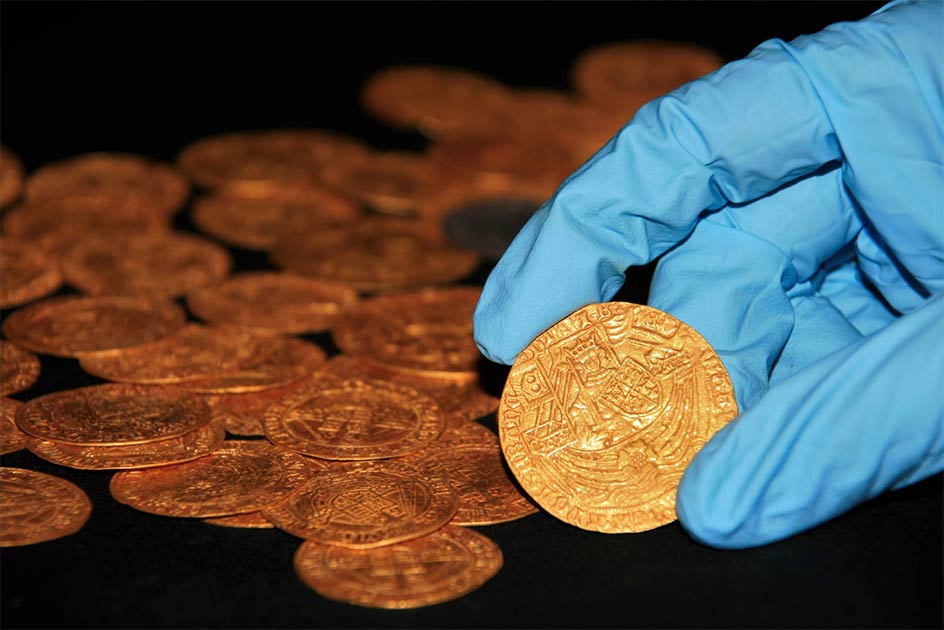47,000 U.K. Pandemic Finds, But This Tudor Coin Hoard Is King!
Around 47,000 historical finds have been recorded with the British Museum’s Portable Antiquities Scheme (PAS) scheme in 2020. According to finds.org, 6,251 of the lost artifacts were reported during the full lockdown from March to May, at a time when metal detecting was prohibited. Amongst the discoveries is the one in a million newly unearthed hoard of Tudor coins discovered in the garden of a New Forest home in England. Some of the coins feature the initials of Catherine of Aragon, Anne Boleyn and Jane Seymour. This, say British Museum coin specialists, raises questions about the marriages of Henry VIII.
A Shocking and Very Interesting Hoard
The once great British Empire is now a forgotten dream, but the Brits still have a highly trained army. I’m not talking about armed soldiers, but legions of metal-detecting enthusiasts and amateur treasure hunters. Ian Richardson, the treasure registrar at the British Museum, said British folk have obviously been spending more time in their gardens, which resulted in a sharp increase of “completely unexpected archaeological discoveries.”
- British Metal Detectorists Find 3 Rare Medieval Coins Worth Thousands!
- 2019: Britain’s Record-Breaking Year of Ancient Treasures
- Closing in on the Jacobite Gold? Jacobite Stash Unearthed in Scotland

These South African Krugerrand gold coins were also discovered. (British Museum / PAS)
Earlier this year a unique Roman furniture fitting with the well-preserved face of the god Oceanus was discovered. Then, only weeks later, fifty apartheid-era South African gold coins were dug up. And now, another surprising find has been reported from a garden in the New Forest. This time 63 gold Tudor coins and one silver coin dating from the 15th and 16th centuries. A report in The Daily Mail quotes the finder, Mr. Richardson, as saying that he and his wife were out turning up the soil in their garden when “all of a sudden these coins popped out of the ground… miraculously.” And he added that it was quite “shocking” and “very interesting” for the pair of them.

Copper alloy Roman furniture fitting with god Oceanus found in Old Basing, Hampshire. (British Museum / PAS)
“A Very Strange Decision” and “Numismatically, Very Interesting”
Barrie Cook, a curator of medieval and early modern coins at the British Museum, says the Tudor hoard contains coins minted during the reign of Edward IV all the way through to his grandson King Henry VIII. Furthermore, most of the gold coins show “angels” on one side and images of the archangel Michael killing a dragon, as described in the Biblical Book of Revelation on the flip side. The coins from the reign of Henry VIII, Mr. Cook says, “are unusual in that they also, separately, feature the initials of three of his wives – Catherine of Aragon, Anne Boleyn and Jane Seymour.” The historian said finding the names of the controversial king’s wives on gold crowns was “a very strange decision” and, “numismatically, very interesting.”

The Tudor coin hoard was particularly interesting. (© The Trustees of the British Museum)
The curators said there “was no precedent” for the placing of Henry’s wives initials on the coinage because Henry divorced Catherine of Aragon, his first wife, in 1533 AD after she failed to produce a male heir. He was then infatuated with Anne Boleyn but that whim led to the schism with the Catholic church which resulted in the English Reformation. And again, this marriage lasted only three years for Anne too failed to bear a prince, thus, she was of course found guilty of adultery, therefore treason, and was famously beheaded on 19 May 1536. Jane Seymour, well she died two weeks after giving birth to a boy who became King Edward VI in 1537 AD, allegedly from postnatal complications.
Buried Quickly, In Fear
Why these ex-wives of the king were minted onto the faces of these coins remains a mystery. However, John Naylor, a coin expert from the Ashmolean Museum, told The Guardian a little of how they got to where they were eventually discovered, in a garden in in the New Forest. Mr. Naylor thinks the coins were probably hidden in about 1540 AD and whoever buried the coins “was well-off,” because the total value of the hoard was £24, equivalent to £14,000 ($18,500) today. “That was a great deal of money, certainly more than the annual wages of the average person,” said Mr. Naylor.
This indicates that the coins were probably buried in the late 1530s and 1540s when the Dissolution of the Monasteries occurred. Naylor suspects that “a churchman or merchant” hid their gold assets quickly during this time of great social upheaval.
Highlighting the importance of this hoard, which one must remember is but one of 47,000 historical finds made in the U.K. in 2020 during the COVID-19 pandemic, the museum coin expert explains that “you don’t get these big gold hoards very often from this period.” One wonders what other marvelous discoveries are just waiting to be made in your back yard!
Top image: Tudor coins discovered in surprising hoard in the garden of a house in the New Forest, Hampshire. Source: The Trustees of the British Museum.
By Ashley Cowie



















